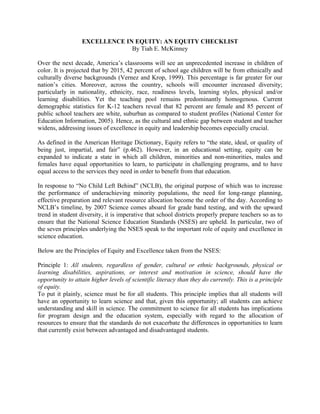
nsta_exequity
- 1. EXCELLENCE IN EQUITY: AN EQUITY CHECKLIST By Tiah E. McKinney Over the next decade, America’s classrooms will see an unprecedented increase in children of color. It is projected that by 2015, 42 percent of school age children will be from ethnically and culturally diverse backgrounds (Vernez and Krop, 1999). This percentage is far greater for our nation’s cities. Moreover, across the country, schools will encounter increased diversity; particularly in nationality, ethnicity, race, readiness levels, learning styles, physical and/or learning disabilities. Yet the teaching pool remains predominantly homogenous. Current demographic statistics for K-12 teachers reveal that 82 percent are female and 85 percent of public school teachers are white, suburban as compared to student profiles (National Center for Education Information, 2005). Hence, as the cultural and ethnic gap between student and teacher widens, addressing issues of excellence in equity and leadership becomes especially crucial. As defined in the American Heritage Dictionary, Equity refers to “the state, ideal, or quality of being just, impartial, and fair” (p.462). However, in an educational setting, equity can be expanded to indicate a state in which all children, minorities and non-minorities, males and females have equal opportunities to learn, to participate in challenging programs, and to have equal access to the services they need in order to benefit from that education. In response to “No Child Left Behind” (NCLB), the original purpose of which was to increase the performance of underachieving minority populations, the need for long-range planning, effective preparation and relevant resource allocation become the order of the day. According to NCLB’s timeline, by 2007 Science comes aboard for grade band testing, and with the upward trend in student diversity, it is imperative that school districts properly prepare teachers so as to ensure that the National Science Education Standards (NSES) are upheld. In particular, two of the seven principles underlying the NSES speak to the important role of equity and excellence in science education. Below are the Principles of Equity and Excellence taken from the NSES: Principle 1: All students, regardless of gender, cultural or ethnic backgrounds, physical or learning disabilities, aspirations, or interest and motivation in science, should have the opportunity to attain higher levels of scientific literacy than they do currently. This is a principle of equity. To put it plainly, science must be for all students. This principle implies that all students will have an opportunity to learn science and that, given this opportunity; all students can achieve understanding and skill in science. The commitment to science for all students has implications for program design and the education system, especially with regard to the allocation of resources to ensure that the standards do not exacerbate the differences in opportunities to learn that currently exist between advantaged and disadvantaged students.
- 2. Principle 2: All students will learn all science in the content standards. This principle addresses an achievement principle, one of excellence. The understandings and abilities described in the content standards are outcomes for all students; they are not different expectations for different groups of students. The standards describe outcomes, not the rate or manner in which students will achieve them. Thus, decisions about programs and the means to accommodate the different rates of learning are left to curriculum developers, state and local school systems, and science teachers. The following checklist provides recommendations and guidance for educational leadership to promote equity: Allocate adequate funds for accountability and testing programs. Provide access to disaggregated data on student performance (by race, ethnicity, gender, income, language, and disability) combined with relevant and target training for teachers/administrators on how to effectively utilize test data to inform instruction. Develop a culturally sensitive, standards based curriculum that is properly aligned with assessment. Create and implement a well-thought out, long-term professional development plan to attract, retain and groom highly qualified teachers. Conduct teacher training and preparation to ensure quality instruction for every child. Specifically, provide guidance for teachers that work in a culturally diverse setting. Ensure placement of students in Special Education programs is correct and put a stop to placement of students due to low reading levels or test scores. Ensure prompt and appropriate intervention for low-performing students. Adopt inclusive assessment techniques that guarantee English language learners and students with disabilities will not be left behind. Share timely information with parents to encourage their involvement in education accountability while employing good “customer service” techniques and being deliberate in building and strengthening strong parental relations. Nurture a school climate that holds high expectations, promotes high performance and supports academic excellence for all students. Finally, The NCLB Act is based on four education reform principles: 1) stronger accountability for results, 2) increased flexibility and local control, 3) expanded options for parents, and 4) an emphasis on teaching methods that have been proven to work. Yet, NCLB alone will not solve all of the longstanding deficiencies in our educational system. Educating our nation’s children has always been and will always be a human endeavor. Achieving “Excellence in Equity” takes courageous educators willing to accept the challenge, make the necessary changes and embrace the belief that all children can learn thereby refusing to lower expectations and standards for any child! As illustrated in the preceding checklist, the fundamental elements of collaboration and empowerment, data-driven decision making, re-examination of core beliefs and values, and effective leadership all play a vital role in attaining “Excellence in Equity”. Tiah E. McKinney serves as a science consultant for several school districts. She can be reached at tmckinne@gmu.edu or visit mason.gmu.edu/~tmckinne